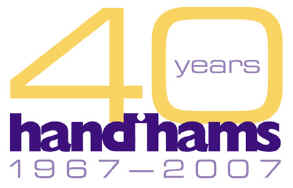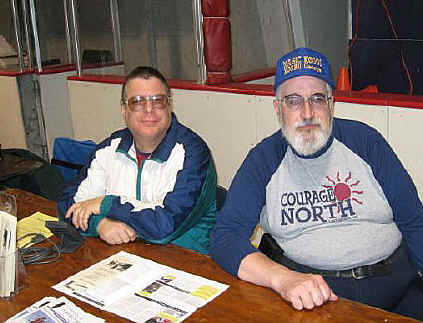 In this issue you will find:
In this issue you will find:
- Hamfest health
- Avery thinks about summer
- In AT: The WA6IVG Resource List
- N1BLF has QST & Worldradio digests ready for April
- New radios for new Techs!
- Reminder: 20 m Monday net changes time.
- Elmer goofs off this week
- In RekkyTec: More good links
Keeping your club's hamfest healthy
 Picture: Volunteers Tim, KA0KOU, and George, N0SBU, staff the Handiham booth at a Minnesota hamfest, "Midwinter Madness", sponsored by the Robbinsdale Amateur Radio Club.
Picture: Volunteers Tim, KA0KOU, and George, N0SBU, staff the Handiham booth at a Minnesota hamfest, "Midwinter Madness", sponsored by the Robbinsdale Amateur Radio Club.
Is there such a thing as a special season for Hamfests? I really don't know, but no matter when your local hamfest might be, you could be there representing a ham radio organization like FISTS, ARRL, SKYWARN, Handihams, or the like. Often times hamfest organizers will give complementary or discount table space to a non-profit organization promoting a specific ham radio related activity.
One of the things that people look for at a hamfest is the presence of these not for profit volunteer-based organizations. Specialty nets might be represented as well, giving attendees the opportunity to speak face-to-face with amateurs they are used to talking with on the air. Other radio clubs around the area may also request table space to get the word out about their specialized activities and mission.
Over the years, hamfests have seen considerable change. A perennial complaint, which I started to hear almost immediately after the introduction of the personal computer as a common household appliance, was that computer equipment started showing up at hamfests and was threatening to overwhelm the sale of used amateur radio equipment. Of course that trend has not changed, and today's typical hamfest features lots of computer-related stuff. In the meantime, used amateur radio equipment has made its way to places like eBay. Even ARRL ran an online auction late in 2006. There is no doubt that the Internet will grow as a source of amateur radio equipment trading.
Personally, I like using the Internet for many things, but the fact of the matter is that it is still fun to see amateur radio equipment "in person" at a hamfest. I hope the tradition of buying and selling used gear at these shows doesn't fade away altogether. But even if it does, local hamfests will still remain an important social event for the ham radio community. I think there will always be some used gear available, and even if some of it is computing equipment, there will always be potential buyers! The challenge is for hamfest organizers to keep their shows viable.
-
If there is not much used gear, why will people attend your club's hamfest? There has to be something of interest to draw them in, so seminars and presentations are now assuming greater importance. No one will want to attend a show that has a few shaky card tables full of 286 computers and no seminars! Getting good speakers takes some planning, so preparation for the next year's hamfest will probably begin at this year's hamfest! And you don't have to spend a lot of money to bring in speakers from out of town, either. Well-prepared and thoughtful presentations from local sources can often work just as well for you.
-
Hamfests cannot exist without volunteer time and expertise. Getting and keeping volunteers is always a challenge, but one thing that can keep things on track is to keep your show to a reasonable size and not take on more than your club can reasonably handle. Nothing burns out volunteers more quickly than a hamfest that is understaffed and requires everyone to put in long, tiring hours. The hamfest should be fun and rewarding for everyone -- especially volunteers! Don't plan a giant gala of a hamfest unless you have legions of volunteers. It is better to start small, grow slowly, and be willing to downsize if necessary.
-
Have you ever been to a hamfest where parking is located so far from the show that you needed to bring a burro to pack your gear along? Yes, we all have, and it isn't any fun is it? I know that it can be challenging to find a decent building in which to hold a hamfest, but one of the core requirements as far as I am concerned is that it needs to be very close to ample, free parking. A show can be killed by parking that costs $10 and is blocks from the arena, even if that arena is the best one in the world. No one wants to lug equipment any farther than necessary, and I can guarantee that you will turn off a lot of people who will expect free parking.
-
Timing is important; some hamfests feature outdoor activities like flea markets. You are taking quite a chance if you schedule your show at a time of year that can experience cold, rainy weather as easily as sunshine. On the other hand, for shows that will be primarily indoors, bad weather like cold temperatures can give people cabin fever and cause them to look forward to the diversion of attending your hamfest! One of our local shows, which is no longer being put on, for years scheduled at the exact same time as a large teacher convention here in Minnesota. The thinking was that more people would be available (out of school) to attend, but there began to be competition for Arena space, families with kids would pack the car and head out of town on short vacations, and parking was either close and expensive or several blocks away. The show was always quite large, requiring many volunteers to be successful. Eventually the pressures became insurmountable, and the show was finally canceled.
As I said, there is no one special secret to keeping a hamfest alive. We live in a dynamic, changing world and we must be willing to adapt. If your club runs a hamfest, remember that you can only be successful if you are willing to change directions and be flexible.
Oh, and be good to your volunteers. They like doughnuts and coffee!